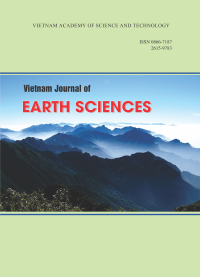Optimized ammonium removal using Al-modified bentonite: Insights into structural and mineralogical changes
Author affiliations
DOI:
https://doi.org/10.15625/2615-9783/22479Keywords:
Al-modified bentonite, ammonium removal, adsorption property, clay, smectitization.Abstract
Highly effective adsorbents derived from modified Di Linh bentonite (Lam Dong Province, Vietnam) were produced using Al3+ stock solution prepared from Al2(SO4)3•18H2O. Mineral, morphology, and surface area properties of untreated and Al-modified Di Linh bentonite were characterized using X-ray diffraction, Fourier transform infrared spectroscopy, scanning electron microscopy, and nitrogen adsorption-desorption analyses. A scanning experiment was conducted to investigate the Al-modified bentonite material's ammonium (NH₄⁺) removal capacity at two levels of NH₄⁺ initial concentration. Results show that the combination of acid H2SO4 (a bioproduct of diluted Al solution) with Al3+ caused the smectitization of clay particles via a dissolution-precipitation mechanism, which enhances the structural organization of smectite and modifies its mineralogical properties. This process promoted the removal capacity of Al-modified bentonites, which increased to 0.47 mg/g in comparison with 0.32 mg/g from untreated bentonite at 50 mg/L NH4+-N concentration, to 19.3 mg/g in comparison with 17.2 mg/g from untreated bentonite at 1000 mg/L NH4+-N concentration. This approach to modifying natural bentonite offers new possibilities for developing adsorbents to eliminate NH4+ from water.
Downloads
References
Abu Hasan H., Sheikh Abdullah S.R., Kamarudin S.K., Tan Kofli N., 2013. On off control of aeration time in the simultaneous removal of ammonia and manganese using a biological aerated filter system. Process Saf Environ, 91(5), 415–422. https://doi.org/10.1016/j.psep.2012.10.001.
Angar Y., Djelali N.E., Kebbouche-Gana S., 2017. Investigation of ammonium adsorption on Algerian natural bentonite. Environ Sci Pollut Res Int, 24, 11078–11089. https://doi.org/10.1007/s11356-016-6500-0.
Anggraini M., Kurniawan A., Ong L.K., Martin M.A., Liu J.C., Soetaredjo F.E., Indraswati N., Ismadji S., 2014. Antibiotic detoxification from synthetic and real effluents using a novel MTAB surfactant montmorillonite (organoclay) sorbent. RSC Adv, 4, 16298–16311. https://doi.org/10.1039/C4RA00328D.
Bayram H., Önal M., Yılmaz H., 2010. Thermal analysis of a white calcium bentonite. J. Therm Anal Calorim, 101, 873–879. https://doi.org/10.1007/s10973-009-0626-y.
Bhattacharyya K.G., Gupta S.S., 2008. Adsorption of a few heavy metals on natural and modified kaolinite and montmorillonite: A review. Adv Colloid Interface Sci., 140(2), 114–131. https://doi.org/10.1016/j.cis.2007.12.008.
Burns S.E., Bartelt-Hunt S.L., Smith J.A., Redding A.Z., 2006. Coupled mechanical and chemical behavior of bentonite engineered with a controlled organic phase. J Geotech Geoenviron Eng., 132(11), 1404–1412. https://doi.org/10.1061/(ASCE)1090-0241(2006)132:11(1404).
Campos J.C., Moura D., Costa A.P., Yokoyama L., Araujo F.V.F., Cammarota M.C., Cardillo L., 2013. Evaluation of pH, alkalinity and temperature during air stripping process for ammonia removal from landfill leachate. J Environ Sci Health A Tox Hazard Subst Environ Eng, 48(9), 1105–1113. https://doi.org/10.1080/10934529.2013.774658.
Cardoso P.L., Celis R., Cornejo J., Valim J.B., 2006. Layered double hydroxide as supports for the slow release of acid herbicides. J Agric Food Chem, 54, 5968–5975.
Chai L., Peng C., Min X., Tang C., Song Y., Zhang Y., Zhang J., Ali M., 2017. Two-sectional struvite formation process for enhanced treatment of copper-ammonia complex wastewater. Trans Nonferrous Met Soc China, 27(2), 457–466. https://doi.org/10.1016/S1003-6326(17)60052-9.
Cheng H., Zhu Q., Xing Z., 2019. Adsorption of ammonia nitrogen in low temperature domestic wastewater by modification bentonite. J. Clean Prod, 233, 720–730. https://doi.org/10.1016/j.jclepro.2019.06.079.
Dontsova K.M., Norton L.D., Johnson C.T., 2005. Calcium and magnesium effect on ammonia adsorption by soil clays. Soil Sci Soc Am J., 69, 1225–1232. https://doi.org/10.2136/sssaj2004.0335.
dos Santos P.R., Daniel L.A., 2020. A review: organic matter and ammonia removal by biological activated carbon filtration for water and wastewater treatment. Int J Environ Sci Technol, 17, 591–606.
Ducey T.F., Vanotti M.B., Shriner A.D., Szogi A.A., Ellison A.Q., 2010. Characterization of a microbial community capable of nitrification at cold temperature. Bioresour Technol, 101(2), 491–500. https://doi.org/10.1016/j.biortech.2009.07.091.
Dukic A.B., Kumric K.R., Vukelic N.S., Dimitrijevic M.S., Bascarevic Z.D., Kurko S.V., Matovic L.L., 2015. Simultaneous removal of Pb2+, Cu2+, Zn2+ and Cd2+ from highly acidic solutions using mechanochemically synthesized montmorillonite-kaolinite/TiO2 composite. Appl Clay Sci., 103, 20–27. https://doi.org/10.1016/j.clay.2014.10.021.
Edwards T.M., Puglis H.J., Kent D.B., Duran J.L., Bradshaw L.M., Farag A.M., 2024. Ammonia and aquatic ecosystems - a review of global sources, biogeochemical cycling, and effects on fish. Sci Total Environ, 907, 167911. https://doi.org/10.1016/j. scito tenv.2023.167911.
Farmer V.C., 1974. The Infrared Spectra of Minerals, Monograph, fourth ed. Mineralogical Society. London.
Han B., Butterly C., Zhang W., He J.-Z., Chen D., 2021. Adsorbent materials for ammonium and ammonia removal: a review. J Clean Prod, 283, 124611. https://doi.org/10.1016/j.jclepro.2020.124611.
Hoang-Minh T., Kasbohm J., Nguyen-Thanh L., Nga P.T., Lai L.T., Duong N.T., Thanh N.D., Thuyet N.T.M., Anh D.D., Pusch R., Knutsson S., Ferreiro Mählmann R., 2019. Use of TEM-EDX for structural formula identification of clay minerals: a case study of Di Linh bentonite, Vietnam. J Appl Cryst, 52, 133–147. https://doi.org/10.1107/S1600576718018162.
Ianchis R., Rosca I.D., Ghiurea M., Spataru C.I., Nicolae C.A., Gabor R., Raditoiu V., Preda S., Fierascu R.C., Donescu D., 2015. Synthesis and
properties of new epoxy-organolayered silicate nanocomposites. Appl Clay Sci., 103, 28–33. https://doi.org/10.1016/j.clay.2014.10.020.
Ji Y., Bai J., Li J., Luo T., Qiao L., Zeng Q., Zhou B., 2017. Highly selective transformation of ammonia nitrogen to N2 based on a novel solar-driven photoelectrocatalytic-chlorine radical reactions system. Water Res, 125, 512–519. https://doi.org/10.1016/j.watres.2017.08.053.
Jorgensen T.C., Weatherley L.R., 2003. Ammonia removal from wastewater by ion exchange in the presence of organic contaminants. Water Res, 37(8), 1723–1728. https://doi.org/10.1016/S0043-1354(02)00571-7.
Krupskaya V.V., Zakusin S.V., Tyupina E.A., Dorzhieva O.V., Zhukhlistov A.P., Belousov P.E., Timofeeva M.N., 2017. Experimental Study of Montmorillonite structure and transformation of its properties under treatment with inorganice acid solutions. Minerals, 7, 49. https://doi.org/10.3390/min7040049.
Kurniawan A., Sutiono H., Ju Y.-H., Soetaredjo F.E., Ayucitra A., Yudha A., Ismadji S., 2011. Utilization of rarasaponin natural surfactant for organo-bentonite preparation: Application for methylene blue removal from aqueous effluent. Microporous Mesoporous Mater, 142(1), 184–193. https://doi.org/10.1016/j.micromeso.2010.11.032.
Lagaly G., Ziesmer S., 2003. Colloid chemistry of clay minerals: the coagulation of montmorillonite dispersions. Adv Colloid Interface Sci., 100–102, 105–128. https://doi.org/10.1016/S0001-8686(02)00064-7.
Li J., Ma H., Yan Y., Zhang J., Li Z., 2024. Molecular insights into the aggregation mechanism of montmorillonite colloid due to calcium contamination: A molecular dynamics simulation study. Appl Clay Sci., 247, 107191. https://doi.org/10.1016/j.clay.2023.107191.
Lin L., Lei Z., Wang L., Liu X., Zhang Y., Wan C., Lee D-J., Tay J.H., 2013. Adsorption mechanisms of high-levels of ammonium onto natural and NaCl-modified zeolites. Sep Purif Technol, 103, 15–20. https://doi.org/10.1016/j.seppur.2012.10.005.
Lin L., Wan C., Lee D.-J., Lei Z., Liu X., 2014. Ammonium assists orthophosphate removal from high-strength wastewaters by natural zeolite. Sep Purif Technol, 133, 351–356. https://doi.org/10.1016/j.seppur.2012.10.005.
Lin S.H., Juang R.S., 2002. Heavy metal removal from water by sorption using surfactant-modified montmorillonite. J Hazard Mater, 92(3), 315–326. https://doi.org/10.1016/S0304-3894(02)00026-2.
Liu Y., Ngo H.H., Guo W., Peng L., Wang D., Ni B., 2019. The roles of free ammonia (FA) in biological wastewater treatment processes: a review. Environ Int, 123, 10–19. https://doi.org/10.1016/j.envint.2018.11.039.
Madejová J., Komadel P., 2001. Baseline studies of The Clay Minerals Society Source Clays: Infrared methods. Clays Clay Miner, 49, 410–432. https://doi.org/10.1346/CCMN.2001.0490508.
Murray H.H., 2007. Applied Clay Mineralogy: Occurrences, Processing and Application of Kaolins, Bentonites, Palygorskite-Sepiolite, and Common Clays. In H. H. Murray (Ed.). Developments in Clay Science. Elsevier, Amsterdam, 2, 180p.
Pandey S., 2017. A comprehensive review on recent developments in bentonite-based materials used as adsorbents for wastewater treatment. J Mol Liq, 241, 1091–1113. https://doi.org/10.1016/j.molliq.2017.06.115.
Rajeshwari K.V., Balakrishnan M., Kansal A., Lata K., Kishore V.V.N., 2000. State of-the-art of anaerobic digestion technology for industrial wastewater treatment. Renew Sustain Energy Rev, 4(2), 135–156. https://doi.org/10.1016/S1364-0321(99)00014-3.
Rybalkina O.A., Tsygurina K.A., Melnikova E.D., Pourcelly G., Nikonenko V.V., Pismenskaya N.D., 2019. Catalytic effect of ammonia-containing species on water splitting during electrodialysis with ionexchange membranes. Electrochim Acta, 299, 946–962.
Rzayev Z.M.O., Uzgoren-Baran A., Bunyatova U., 2015. Functional organo-Mt/copolymer nanoarchitectures: microwave-assisted rapid synthesis and characterization of ODA-Mt/poly[NIPAm-co-(MA-alt-2,3-2H-DHP)] nanocomposites. Appl Clay Sci, 105–106, 1–13. https://doi.org/10.1016/j.clay.2014.12.015.
Şahin D., Öz M., Sertaşi E., Öz Ü., Karsli Z., Aral O., 2018. Evaluation of natural minerals (zeolite and bentonite) for nitrogen compounds adsorption in different water temperatures suitable for aquaculture. Int Lett Nat Sci, 71, 34–42. https://doi:10.18052/www.scipress.com/ILNS.71.34.
Sapag K., Mendioroz S., 2001. Synthesis and characterization of micromesoporous solids: pillared clays. Colloids Surf A: Physicochem Eng Asp, 187–188, 141–149. https://doi.org/10.1016/S0927-7757(01)00617-3.
Seki Y., Yurdakoç K., 2005. Paraquat adsorption onto clays and organoclays from aqueous solution. J Colloid Interface Sci, 287(1), 1–5. https://doi.org/10.1016/j.jcis.2004.10.072.
Sing K.S.W., Everett D.H., Haul R.A.W., Moscou L., Pierotti R.A., Rouquerol J., Siemieniewska T., 1984. Reporting physisorption data for gas/solid systems with special reference to the determination of surface area and porosity. Pure Appl Chem, 57, 603–619. https://doi.org/10.1351/pac198557040603.
Sotoft L.F., Pryds M.B., Nielsen A.K., Norddahl B., 2015. Process simulation of ammonia recovery from biogas digestate by air stripping with reduced chemical consumption. In: Gernaey KV, Huusom JK, Gani R (Eds.) Computer Aided Chemical Engineering. Elsevier, 2465–2470.
Srinivasan R., 2011. Advances in application of natural clay and its composites in removal of biological, organic, and inorganic contaminants from drinking water. Adv Mater Sci Eng, 872531. https://doi.org/10.1155/2011/872531.
Storck S., Bretinger H., Maier W.F. 1998. Characterization of micro- and mesoporous solids by physisorption methods and pore-size analysis. Appl Catal A: General, 174, 137–146. https://doi.org/10.1016/S0926-860X(98)00164-1.
Sun Z.M., Qu X.S., Wang G.F., Zheng S.L., Frost R.L., 2015. Removal characteristics of ammonium nitrogen from wastewater by modified Ca-bentonites. Appl Clay Sci., 107, 46–51. https://doi.org/10.1016/j.clay.2015.02.003.
Thommes M., Kaneko K., Neimark V.A., Oliver P.A., Rodriguez-Reinoso F., Rouquerol J., Sing S.W., 2015. Physisorption of gases, with special reference to the evaluation of surface area and pore size distribution (IUPAC Technical report). Pure Appl Chem, 87(9–10), 1051–1069. https://doi.org/10.1515/pac-2014-1117.
Tomić Z.P., Antić Mladenović S.B., Babić B.M., Poharc Logar V.A., Djordjević A.R., Cupać S.B., 2011. Modification of smectite structure by sulfuric acid and characteristics of the modified smectite. J Agric Sci, 56, 25–35. https://doi.org/10.2298/JAS1101025T.
Tran D.T., Pham T.D., Dang V.C., Pham T.D., Nguyen M., Dang N.M., Ha M.N., Nguyen V.N., Nghiem L.D., 2022. A facile technique to prepare MgO-biochar nanocomposites for cationic and anionic nutrient removal. J Water Process Eng, 47, 102702. https://doi.org/10.1016/j.jwpe.2022.102702.
Tu Y., Feng P., Ren Y., Cao Z., Wang R., Xu Z., 2019. Adsorption of ammonia nitrogen on lignite and its influence on coal water slurry preparation. Fuel, 238, 34–43. https://doi.org/10.1016/j.fuel.2018.10.085.
Vanamudan A., Pamidimukkala P., 2015. Chitosan, nanoclay and chitosan–nanoclay composite as adsorbents for Rhodamine-6G and the resulting optical properties. Int J Biol Macromol, 74, 127–135. https://doi.org/10.1016/j.ijbiomac.2014.11.009.
Viennet J., Hubert F., Tertre E., Ferrage E., Robin V., Dzene L., Cochet C., Turpault M., 2016. Science direct effect of particle size on the experimental dissolution and autoaluminization processes of K-vermiculite. Geochim Cosmochim Acta, 180, 164–176. https://doi.org/10.1016/j.gca.2016.02.005.
WHO (World Health Organization), 2011. Guidelines for drinking water quality (Fourth ed.). World Health Organization, Geneva.
Wijesinghe D.T.N., Dassanayake K.B., Sommer S.G., Jayasinghe G.Y., Scales P.J., Chen D., 2016. Ammonium removal from high-strength aqueous solutions by Australian zeolite. J Environ Sci Health A, 51(8), 614–625. Doi: 10.1080/10934529.2016.1159861.
Yang H., Li D., Zeng H., Zhang J., 2019. Impact of Mn and ammonia on nitrogen conversion in biofilter coupling nitrification and ANAMMOX that simultaneously removes Fe, Mn and ammonia. Sci Total Environ, 648, 955–961. https://doi.org/10.1016/j.scitotenv.2018.08.223.
Zamparas M., Drosos M., Georgiou Y., Deligiannakis Y., Zacharias I., 2013. A novel bentonite-humic acid composite material Bephos™ for removal of phosphate and ammonium from eutrophic waters. Chem Eng J, 225, 43–51. https://doi.org/10.1016/j.cej.2013.03.064.
Zheng H., Han L., Ma H., Zheng Y., Zhang H., Liu D., Liang S., 2008. Adsorption characteristics of ammonium ion by zeolite 13X. J Hazard Mater, 158(2), 577–584. https://doi.org/10.1016/j.jhazmat.2008.01.115.
Zhou C.H., Zhang D., Tong D.S., Wu L.M., Yu W.H., Ismadji S., 2012. Paper-like composites of cellulose acetate–organo-montmorillonite for removal of hazardous anionic dye in water. Chem Eng J, 209, 223–234. https://doi.org/10.1016/j.cej.2012.07.107.








